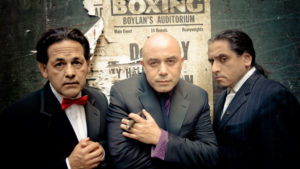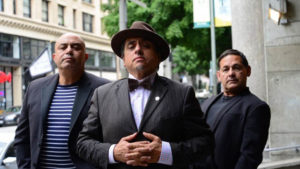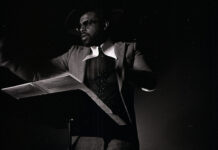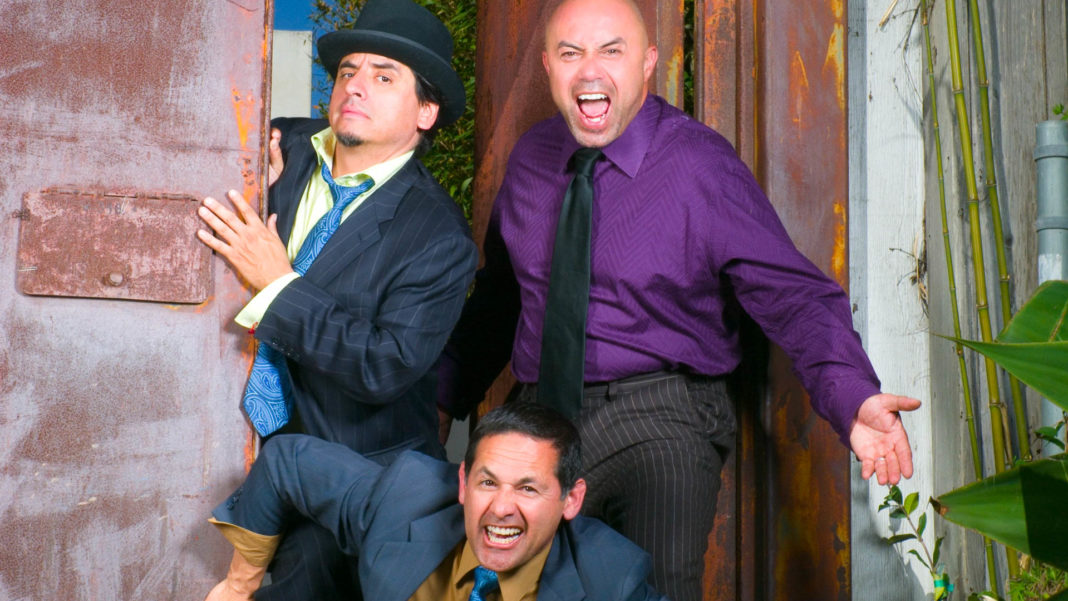Two decades have passed since the ensemble group Culture Clash premiered Bordertown. And a lot has changed in those twenty years. Not only have Richard Montoya, Ric Salinas and Herbert Sigüenza gotten older, but the country they were examing then has become wildly polarized now – particularly on the subject of immigration. So they enlisted director Diane Rodriguez to help them launch version 2.0 of their play: Bordertown Now which begins previews tomorrow at the Pasadena Playhouse.

Rodriguez, who serves as Associate Artistic Director at Center Theatre Group, is a director, writer and performer. She was appointed by President Obama to the National Council on the Arts, a position she maintains today. So when we talked about Bordertown Now, the issues presented in the piece and the state of affairs in the country, she was keenly aware of having to walk a very fine line.
In your 2014 piece The Movement of All Things, you talked about believing that “the artist was a creator seer, a trickster who illuminated, disrupted, challenged cultures so in need of constant reflection and change.” What role does humor play in accomplishing the goals you laid out?
I think that humor dismantles and it subverts and it allows people to listen. And I think that you’ll see that the way the show is structured is that we actually start off that way. We let everyone relax and get to know everybody, trust they are in good hands, that we’re taking the subject matter seriously, but not ourselves seriously in terms of artists who are trying to attack a serious issue.
Given how polarized we are as a country, what is the goal of Bordertown Now?
It’s not that we are standing in the middle of the issue, we have our opinions about how this country is so fearful or why this country is so fearful of immigrants, particularly those from Mexico and Central America. We understand what’s going on. It’s not about us. It’s about illuminating and giving more information to our audiences so they will be able to discern and to offset their fear. I think that’s why this piece is so important.
With everything that has happened over the past 20 years since the play was first performed, how different is Bordertown Now than its predecessor?
We should figure out what percentage of the old show is in the new show. I would venture that it’s 80% new material. Maybe three characters from the original have survived. The form has survived – the chroniclers who have gone out to do interviews – but the material in it has changed because obviously the issues have. Not that they have evolved, but that the characters have changed. Culture Clash has responded to that change. We’ve had to respond.

Photo provided courtesy of Culture Clash
Not only has the political environment changed, but so have the guys in Culture Clash. How are they different today than where they were in 1998?
I think they are really trying to not do as much sketch. There are just things they don’t want to do as veteran performers. They want to get deeper. I think their perception has changed. They are much more mature performers and they have more tools to delve deeper.
Does theatre like this risk preaching to the converted?
We don’t really know what people’s politics are. We just don’t. That is crucial. That’s why we have to be doing our work. We have to present the work and here’s this side of the story and here is the discussion with that other side for you to hear so you can hear both sides of the discussion. That’s what we’re trying to do with Bordertown Now. Hopefully that will open up the conversation and not remain so silent.
With campaigns like #OscarSoWhite, the main beneficiaries seem to be African-American actors. Does it disturb you that the Latinx experience is absent from a lot of productions and casting decisions?
Yes. It’s always something we’re pushing and trying to do more of. There is a movement happening. Sometimes I wonder how patient can we be? Sometimes I think my God, I’ve been doing this for all my adult life and there have been bright spots, but it just hasn’t moved fast at all. When is it going to happen? Theatres that have the resources are not in the hands of folks who generationally understand or have the relationship with Latinx artists and other diverse folks. There is a transition happening in the country, but I wouldn’t say it’s overwhelmingly turning over the power structure.

Photo provided courtesy of Culture Clash
Artists often do their best work in a time of turmoil. Does the state of our union lead you to believe that important work will come out of our present condition?
When you are an artist, you have to create. I think I am not at peace if I’m not doing something creative and saying something. I’m just not. It’s just who I am and I know so many people who are like me. It doesn’t matter what climate you live in, you are always trying to find a way to tell a story. I think that we do it under whatever circumstances. Part of what Bordertown Now is about is that we as artists are witnesses and chroniclers and our greatest crime would be to be silent. So we must say something.










